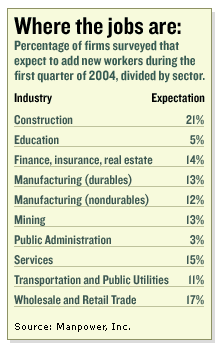NEW YORK (CNN/Money) - If you've been among the ranks of the long-term unemployed, many things may seem easier things to accomplish than finding work: performing open-heart surgery, finding your true love, or mastering Sanskrit.
But a job hunter's life may soon get a little bit easier.

At least that's the cautiously optimistic finding from Manpower Inc., a temporary staffing firm in Milwaukee.
According to the company's most recent survey, 20 percent of U.S. employers plan to hire more staff during the first quarter of 2004. Traditionally, that's the slowest quarter of the year for hiring. After accounting for seasonal adjustments, the number of employers saying they plan to increase their workforces is 13 percent.
"There seems to be traction in the labor market, which will make it slightly easier for people to find a job," said Jeffrey Joerres, chairman and CEO of Manpower. "But we're still in a marketplace where people need to search for a good job."
Things will look brighter nationwide, and across most industries. Jobs in 9 of 10 sectors – from construction to retail to manufacturing and finance – should become more plentiful compared to the final quarter of 2003. Only the outlook for public-sector work looks weak.
Job prospects in construction, which haven't been this strong since the first quarter of 2001, should lead the growth. Some 21 percent of construction employers plan to hire from January through March, according to the Manpower study.
Manufacturing, which has shed 2.8 million jobs since 2001, also shows some promising signs. Thirteen percent of employers plan to hire workers in factories that make durable items like heavy equipment and cars. Twelve percent of makers of non-durable goods expect to add to their payrolls.
"Those are sizable gains," said Joerres. "We're seeing manufacturers, which are a major driver to the economy, feeling a bit better about the sustainability of their demand."
Government employees -- particularly state-level workers -- will have a difficult time of it, though. Jobs should remain flat in the coming year as governments grapple with steep budget cuts.
Overall, the number of full-time state workers will drop 2.8 percent as 10 states plan on cutting staff. Some states will use early retirement incentives to trim their payrolls, according to National Governors Association's "Fiscal Survey of States" report released this month.

|

